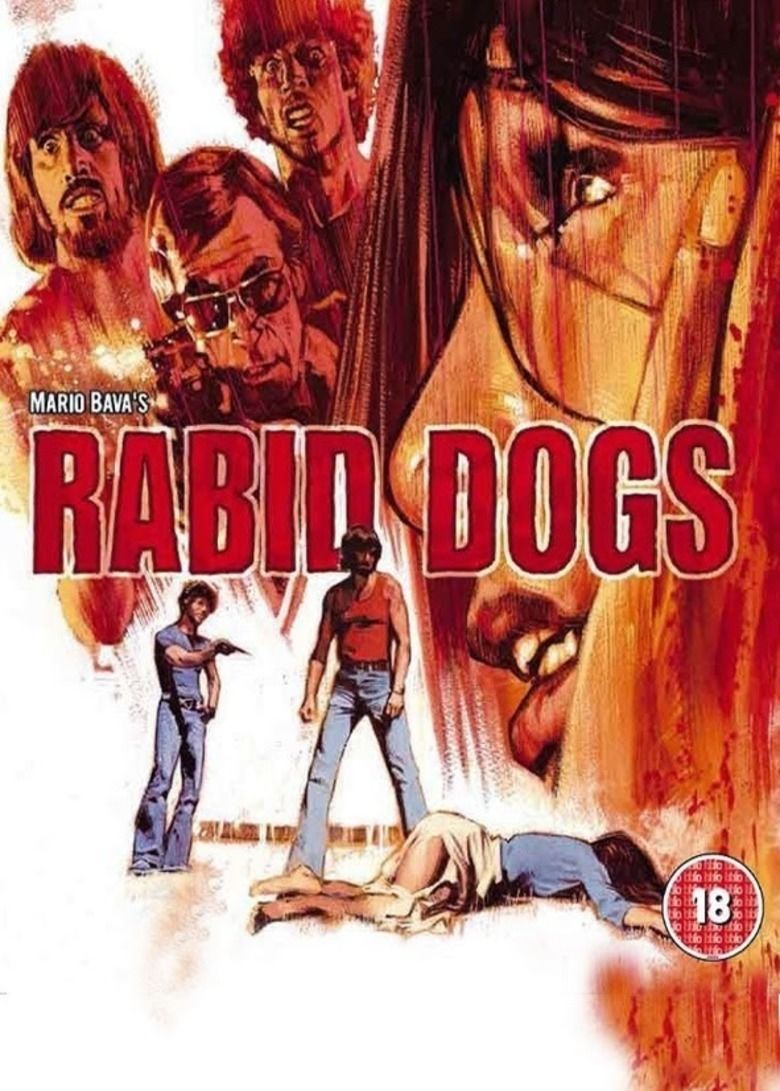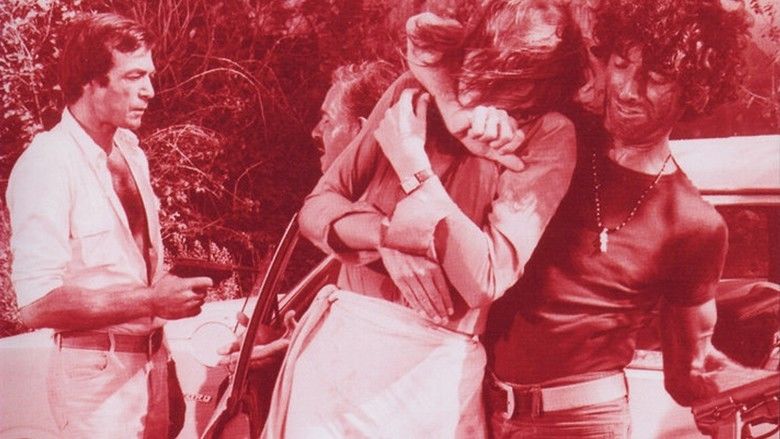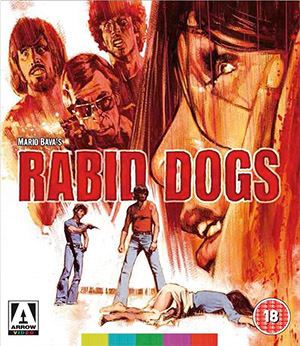Rabid Dogs
8 /10 1 Votes8
Country Italy | 7.8/10 IMDb Duration | |||||||||||||||||||||||||||||||||
 | ||||||||||||||||||||||||||||||||||
Release date 24 February 1998 (see release dates) Writer Alessandro Parenzo (screenplay), Alessandro Parenzo (story) Tagline Lock the doors, rollup the windows, and buckle up… for the ride of your life! | ||||||||||||||||||||||||||||||||||
Rabid dogs 1974 trailer for mario bava s final film that wasn t actually released until 1997
Rabid Dogs is an Italian film directed by Mario Bava. The film stars Riccardo Cucciolla, Aldo Caponi and George Eastman. Rabid Dogs is about a group of bank robbers who kidnap a young woman (Lander). During their escape, they also take in a man and his sick child, all while trying to avoid being caught by the police.
Contents
- Rabid dogs 1974 trailer for mario bava s final film that wasn t actually released until 1997
- Rabid dogs the arrow video story
- Plot
- Style
- Production
- Release
- Home video
- Critical reception
- Aftermath and influence
- References

Rabid Dogs was a departure for Bava, who was known for his colourful horror films prior to creating Rabid Dogs. Bava finished filming in three weeks but found during post-production that his producer Roberto Loyola had gone bankrupt, which stopped any kind of production continuing since the producer still owned the rights. The film remained uncompleted and unseen for 20 years until it began showing up in several different formats on home video with added scenes for continuity and endings. Several different versions of the film exist, including one re-created by Mario's son Lamberto Bava, which was not well received.

Rabid dogs the arrow video story
Plot
Four criminals rob an armored truck carrying the wages of a pharmaceutical company, but during their getaway their car is damaged and one of them is killed. The remaining three criminals, Doc (Maurice Poli), Blade (Aldo Caponi) and Thirty-Two (Luigi Montefiori) are forced to flee on foot into an underground car park, pursued by the police. The criminals grab two women as hostages, and when Blade accidentally kills one, the police, seeing the other hostage Maria (Lea Lander) in danger, back away, allowing the criminals to steal her car and escape. Doc knows that its only a matter of time before a description of their new getaway car reaches the authorities, so they hijack another car at gunpoint. The middle-aged driver of this car, Riccardo (Riccardo Cucciolla), protests that he has to get his young child – a small, deathly-pale little boy wrapped up in a blanket – to a hospital, but the criminals force Riccardo to drive them out of the city towards their hideout.
During most the long road journey, Maria cannot stop herself from shaking and quaking with fear, which annoys Blade and Thirty-Two. Riccardo on the other hand takes what's happening to him very calmly. Blade and Thirty-Two frequently fondle Maria who continues to tremble constantly, and Doc is barely able to keep them in line. At a traffic construction site, Doc forces the group to roll their windows up, which attracts some attention because it is the middle of a hot summer day. But Doc has them roll their windows back down, and the group continues on. A little later, Maria asks Doc to pull the car over so she can relieve herself, then tries to escape. Blade and Thirty-Two chase her to an unoccupied farmhouse, recapture her, and then force her to urinate in front of them as punishment.
Back on another autostrade, Riccardo asks Doc if can pull into a rest stop for food and supplies. With Thirty-Two accompanying him, Riccardo buys some sandwiches and soda pop, while Thirty-Two buys a bottle of scotch. When a random woman at the rest area recognizes Riccardo, he manages to shake her off by saying that he's going on a picnic in the countryside with some friends.
Back on the expressway, Thirty-Two becomes intoxicated from the bottle of liquor he bought, and his actions begin to draw attention from other motorists. Doc and Blade try to control him, but he gets more and more out of control, and he attempts to rape Maria. Rather than risk attracting the attention of the highway police, Doc shoots Thirty-Two in the neck. Blade is completely shaken by this, but understands that Doc had no other choice. Thirty-Two does not die, but becomes completely helpless and immobile.
Soon after this incident, Riccardo tells them that they need to stop for gas. However, when they finally reach a rural Esso filling station, the elderly attendant (Francesco Ferrini) tells them that he's on his hour break and won't help them for at least another 20 minutes. Doc, in a hurry to complete their journey, attempts to threaten the old man, who instead pulls a gun on Doc telling them that he was robbed the previous year and cannot be intimidated. Blade forces Maria to smooth things over by pleading with the attendant to come out and fill their car so they can get the comatose little boy to a hospital. The old man relents, but another complication arises when an overly cheerful young woman (Eriak Dario) shows up at the station claiming that her car had broken down and that she needs assistance. Seeing the group, she pressures Doc into giving her a ride to the next town. When the woman opens the side door to the car, Thirty-Two's hand, covered with his own blood, slumps into view. The woman fails to see this, but the attendant does. Rather than risk a scene, Doc allows the woman to come along with them. The old man returns to his office with a shrug.
The hitchhiker, also named Maria, talks constantly, which annoys everyone. She is also completely oblivious to the situation. When she inadvertently removes the blanket covering Thirty-Two's neck, revealing the bullet wound, Blade kills her. Doc forces Riccardo to pull over so they can dispose of the body. They also carry the still-breathing Thirty-Two out of the car, and Blade shoots his mortally wounded friend to put him out of his misery.
The group finally reaches the gang's hideout: a ruined villa just south of Naples where Doc has stashed a back-up car, carrying the appropriate papers that will enable him and Blade to leave the country. Riccardo and Maria are elated, but Doc reveals that he intends to kill hostages to secure their escape. Riccardo tries to persuade Doc to let the little boy, who has been in a sedative-induced sleep for the whole duration, live. But Doc refuses and orders Riccardo to remove the little boy from the car. As Riccardo does so, he pulls out a gun hidden all this time in the child's blanket and shoots both Doc and Blade, who fatally injures Maria with his machine gun before expiring. With the tires of the car flat from the bullet hits, Riccardo moves the child to Doc's getaway car, takes the stolen money, and drives off.
In a final twist, it is revealed that Riccardo, too, has a dark secret of his own: he is really a criminal who kidnapped the young child from its real parents and he phones the child's mother in the final scene to tell her to pay a ransom of six million lire and he will call back to give further instructions. Riccardo returns to his new car containing the child in the trunk and drives away.
Style
Unlike Bava's earlier films that showcased garish colors and outlandish camera angles, Rabid Dogs was described by Roberto Curti as not even looking like the work of the same director. The film starts similar to the poliziotteschi films that were growing popular in Italy in the 1970s, but lacks the sociological insights those films had.
Production
In the early 1970s, director Mario Bava was facing difficulty in his career. He received freedom to make the type of film he wanted with Lisa and the Devil (1972) which was shelved after it received negative audience reaction at the Cannes Market. Another Bava film, Bay of Blood was also disappointing in the box office. This led to him trying a new project from anything he had done previously as he began developing thef ilm L'uomo e il bambino (The Maan and the Boy) based on short story found in an issue of Giallo Mondadori. The films screenplay was written by Alessandro Parenzo and an uncredited Cesare Frugoni. Principal photography on the film began in August 1973 with Bava deciding to shoot everything in chronological order. The film was shot on the road along the Roma-Civitavecchia motorway.
The films protagonist was originally portrayed by Al Lettieri, but after arriving on set at 9 o'clock in the morning drunk, he was replaced in three days by Riccardo Cucciolla. Cucciolla could not speak English, and according to co-star Maurice Poli, had to read his lines in English from the script that was placed strategically around the car. Mario Bava's son, Lamberto Bava who was the assistant director on the film has mentioned several problems with producer Roberto Loyola. Lamberto Bava mentioned that Loyola had money issues, and that the crew stopped working after their cheques were not dated in the first week. After Loyola signed them, the crew continued work to only find later that all of their cheques had bounced. Despite these problems, Mario Bava was able to complete principal shooting in three weeks. During filming, the film's title became Ore 9 Semaforo (9 A.M. - Red Light) and later Cani Arrabbiati.
All that remained to be filmed was some cutaway shots involving helicopters and police cars and a pre-credit sequence. The producer went bankrupt during this period, and had the production shelved. Both Lamberto and Mario attempted to regain possession of the film, but were unable to retrieve the rights to complete it.
Release
Rabid Dogs was screened in 1995 at the Mifed film market in Milan. This version was titled Semaforo rosso (Red Traffic Light) and was developed by Lea Lander's group Spera Cinematografica with funding from German film journalist Peter Blumenstock. Lamberto Bava stated that this version was completed against his wishes and created from a rough cut of the film assembled by Carlo Reali while originally filming. This version included shot-on-video inserts to connect footage and the addition of a police siren sound at the end of the film. As the film was shot without sound, the soundtrack and dubbing had to be completely redone. This version had its premiere at the 14th Brussels International Film Festival in 1996.
Home video
The first DVD of the film was limited to 2000 discs from Blumenstock's label Lucertola Media in 1998. This version lost Spera's inserts and kept the original ending of the film which was shot per Bava's script indications. The film was released again in Germany in 2001 through the Astro label. The Astro version does not contain the prologue and features a longer take of the films ending. Following this, a fourth version was developed as a rough draft by Alfredo Leone. This version includes more video footage of missing cutaway shots, two new scenes shot on video in the end of the film and ends with a zoom-in and freeze-frame of a mother's face. A fifth version of the film was released by with both Leone and Lamberto Bava, which added stock footage of 1970s police cars and new scenes shot on 35mm by Lamberto and Roy Bava between April and May 2001. This version contains new dubbing and a new music score by Stelvio Cipriani. Lamberto Bava edited this version with Mauro Bonanni which cut parts of the film he felt Mario Bava would not have wanted.
Roberto Curti has stated that among the above versions, the Astro version was the best release as the Leone/Lamberto Bava release was "nothing short of a mess, albeit a well-intentioned one". The DVD released by Anchor Bay contains the Leone and Lamberto Bava version of the film titled Kidnapped as well as the Lucertola version. A Blu-ray of the film was released by Kino Lorber in the United States which only contains the Leone and Bava version titled Kidnapped. In the United Kingdom, Arrow Video released a Blu-ray that contained both Kidnapped and the version seen on the American Anchor Bay release. The Lucertola version on Arrow Video's Blu-ray contains parts in standard definition as no complete film print could be found after the re-cut version titled Kidnapped was created.
Critical reception
Tim Lucas, author of the critical biography Mario Bava: All the Colors of the Dark, calls the film "an exceptional work in the distinguished career of Mario Bava" and states that Rabid Dogs is to Bava's career what Detour (1945) is to the filmography of Edgar G. Ulmer, a minimalist noir masterpiece that shows how much drama he was capable of conjuring onscreen with little or no means."
On reviewing the 'Semaforo rosso version, Slant Magazine gave the film three and a half stars out of four, declaring that the "final plot twist so shocking that it forces the spectator to reevaluate everything that transpired prior. Quite cynically, Bava evokes a human society where no one is to be trusted". Reviewing the Arrow Video Blu-ray, Fangoria declared that the Semaforo rosso cut superior to Kidnapped, noting that Kidnapped "is still a striking film, just one that was altered from the original intent in a few unflattering ways." and the Rabid Dogs was an "overlooked masterpiece ranks up there with [Mario Bava's] best movies."
Aftermath and influence
Rabid Dogs was remade under the same title as the debut feature by Eric Hannezo in 2015.
References
Rabid Dogs WikipediaRabid Dogs IMDb Rabid Dogs themoviedb.org
